Georgia O’Keeffe: “My New Yorks”
PDF: Custer, review of My New Yorks
Curated by: Sarah Kelly Oehler and Annelise K. Madsen, Art Institute of Chicago
Exhibition Schedule: Art Institute of Chicago, June 2–September 22, 2024; High Museum of Art, Atlanta, October 25, 2024–February 16, 2025
Exhibition Catalogue: Sarah Kelly Oehler and Annelise K. Madsen, Georgia O’Keeffe: “My New Yorks,” exh. cat. Chicago: Art Institute of Chicago, in association with Yale University Press, 2024. 216 pp.; 168 color illus. Hardcover: $50.00 (ISBN: 9780300275759)
“My New Yorks would turn the world over,” wrote Georgia O’Keeffe to the art critic Henry McBride in an undated letter, likely from March 1925.1 Here, she referred to her paintings and drawings of Midtown Manhattan made between the mid-1920s and the early 1930s. These works present the dynamic city in sweeping horizontal views from her apartment on the thirtieth floor of the Shelton Hotel (the tallest residential hotel in New York at that time) and in vertical building “portraits” that feature singular edifices. Taking the phrase “my New Yorks” as its titular scope, Georgia O’Keeffe: “My New Yorks,” organized by the Art Institute of Chicago, builds on existing art-historical scholarship to examine her cityscapes—the first museum exhibition to do so in such depth (fig. 1).2 By situating O’Keeffe’s urban subjects within the context of her contemporaneous and wide-ranging aesthetic experiments—magnified flowers, the landscape of the American Southwest, and abstractions in color, light, and form—this exhibition makes clear that we cannot understand O’Keeffe without understanding her “New Yorks.”
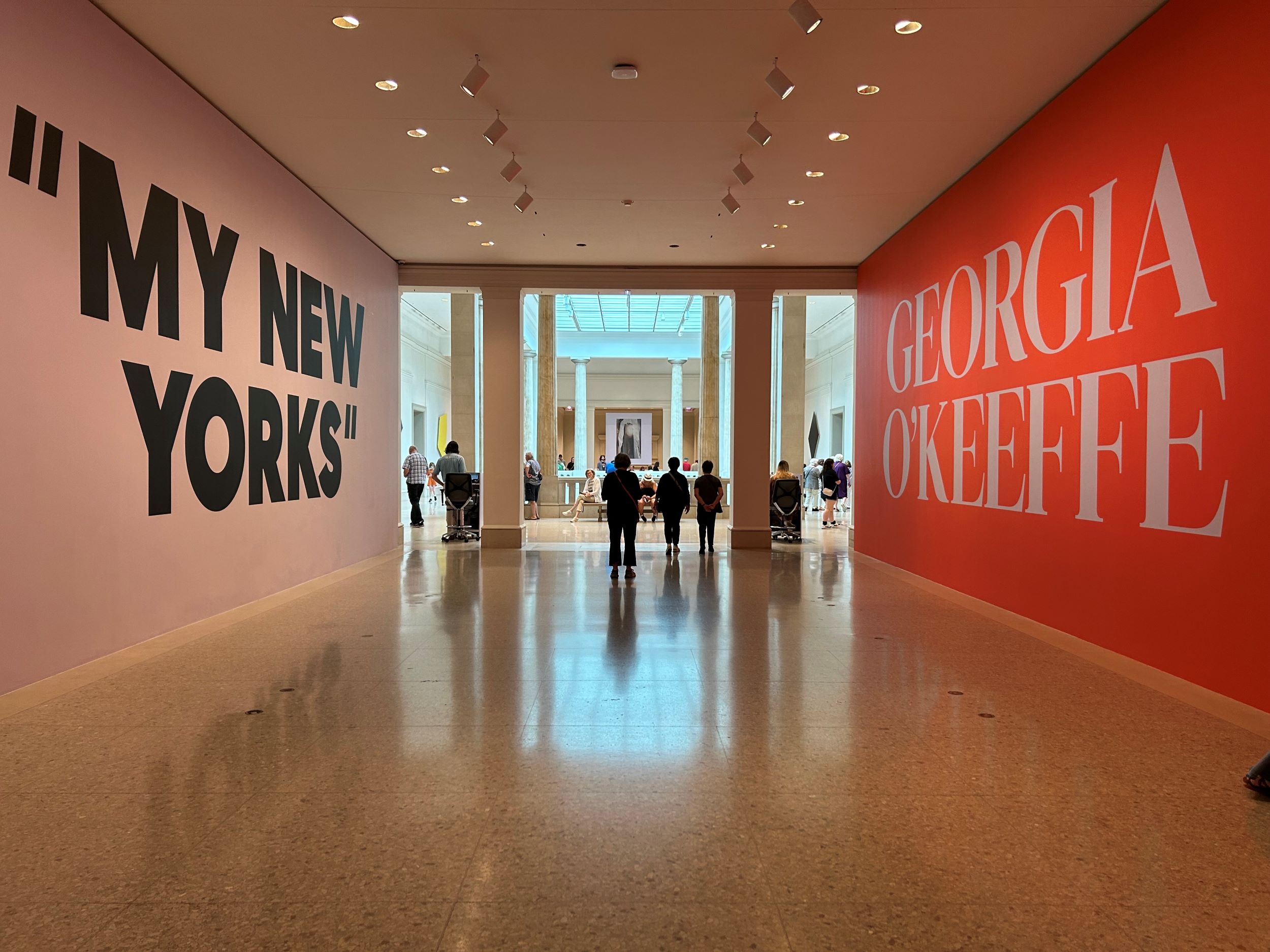
Organized into six roughly chronological sections, plus an introduction and a coda, Georgia O’Keeffe: “My New Yorks” traces the artist’s biography alongside her related works, foregrounding the importance of place and positioning New York (particularly the Shelton) as a critical node that informs O’Keeffe’s oeuvre. The artist’s “New Yorks” are dispersed throughout the show, with at least one major work that depicts New York anchoring each gallery. The galleries are spacious and flow into one another, punctuated with direct quotes from O’Keeffe on the walls and blocks of text that introduce the focus of each grouping.
The opening section is grounded in exhibition history. It references the 1925 exhibition Seven Americans, which was arranged by O’Keeffe’s husband, the photographer and gallerist Alfred Stieglitz. At that time, Stieglitz declined to display O’Keeffe’s early cityscape, New York Street with Moon (1925), opting instead to show her nonurban subject matter, such as leaves, vegetables, and rural sites. The Art Institute’s 2024 display revises the historic snub, showing that canvas alongside other works, including The Chestnut Tree—Grey (1924) and The Eggplant (1924), that were part of the original 1925 show (fig. 2). Through this gesture, the curators stress how polemical the subject of New York was for O’Keeffe at that time—and how much control Stieglitz had over her career in the 1920s. Her “New Yorks” thus emerge as a vehicle through which she asserted her own artistic vision and persona.
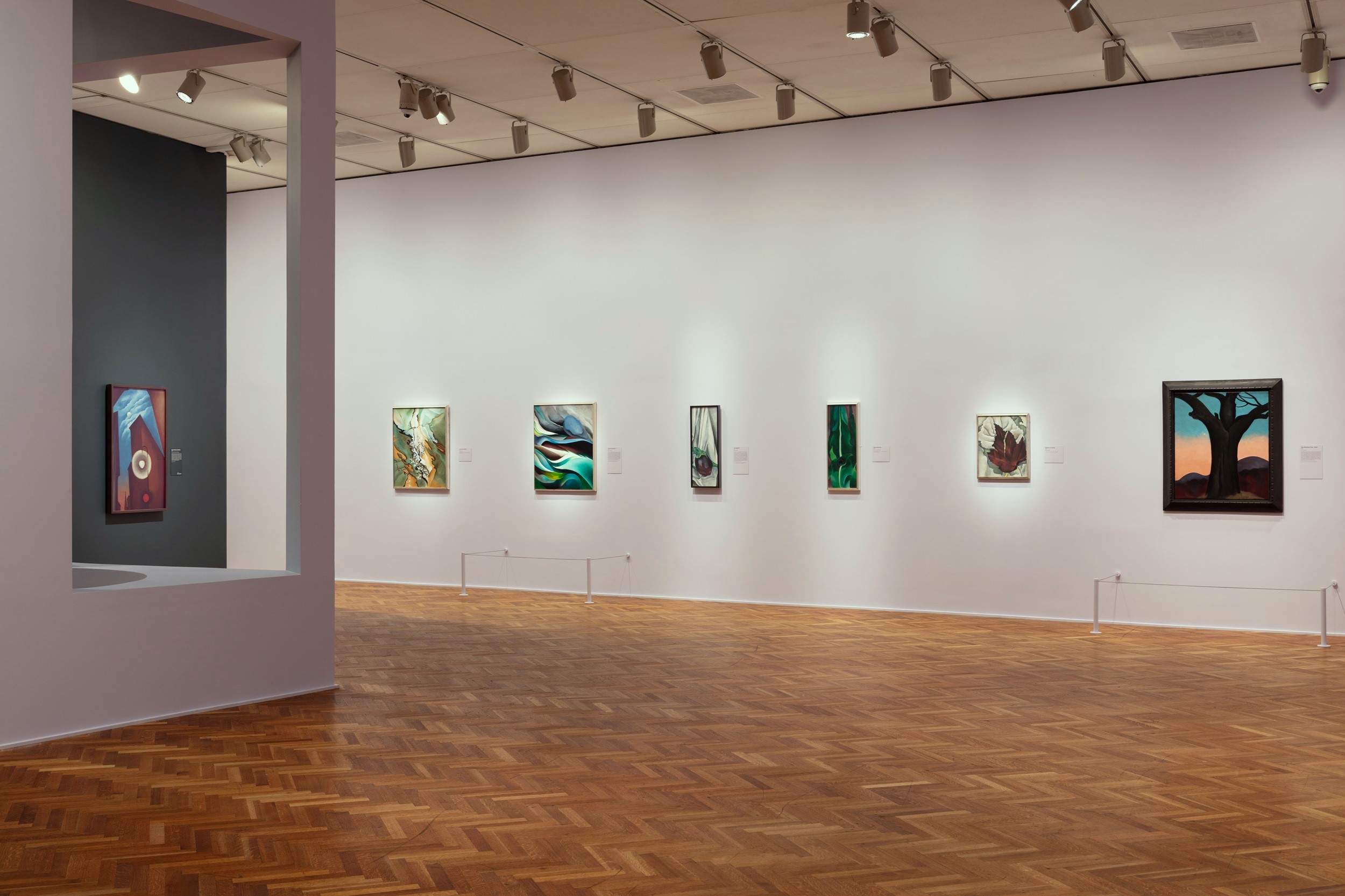
The show then spotlights the Shelton: the building, O’Keeffe’s experience living there, and her depictions of its façade. The thirty-one-story structure was significant not only for its height but also because architects heralded it as a paradigmatic example of building massing under the city’s new zoning resolution of 1916, which required that buildings step back from the street line as they rose higher to allow for more light and air to filter down to the streets below. The Shelton with Sunspots, N.Y. (1926) pictures sunlight permeating the city; the sun overtakes the blocky mass of the Shelton Hotel—or takes “a bite out of one side of the tower,” to use O’Keeffe’s phrase (fig. 3).3 Beside this painting is Shelton Hotel, N.Y., No. 1 (1926). These two paintings are her only extant views of the Shelton’s exterior; she made at least four and destroyed the others, unsatisfied with them.4 One charcoal drawing of the westward view from the Shelton is displayed in this section as well; her series of depictions of her view of the East River from the hotel are several galleries ahead.
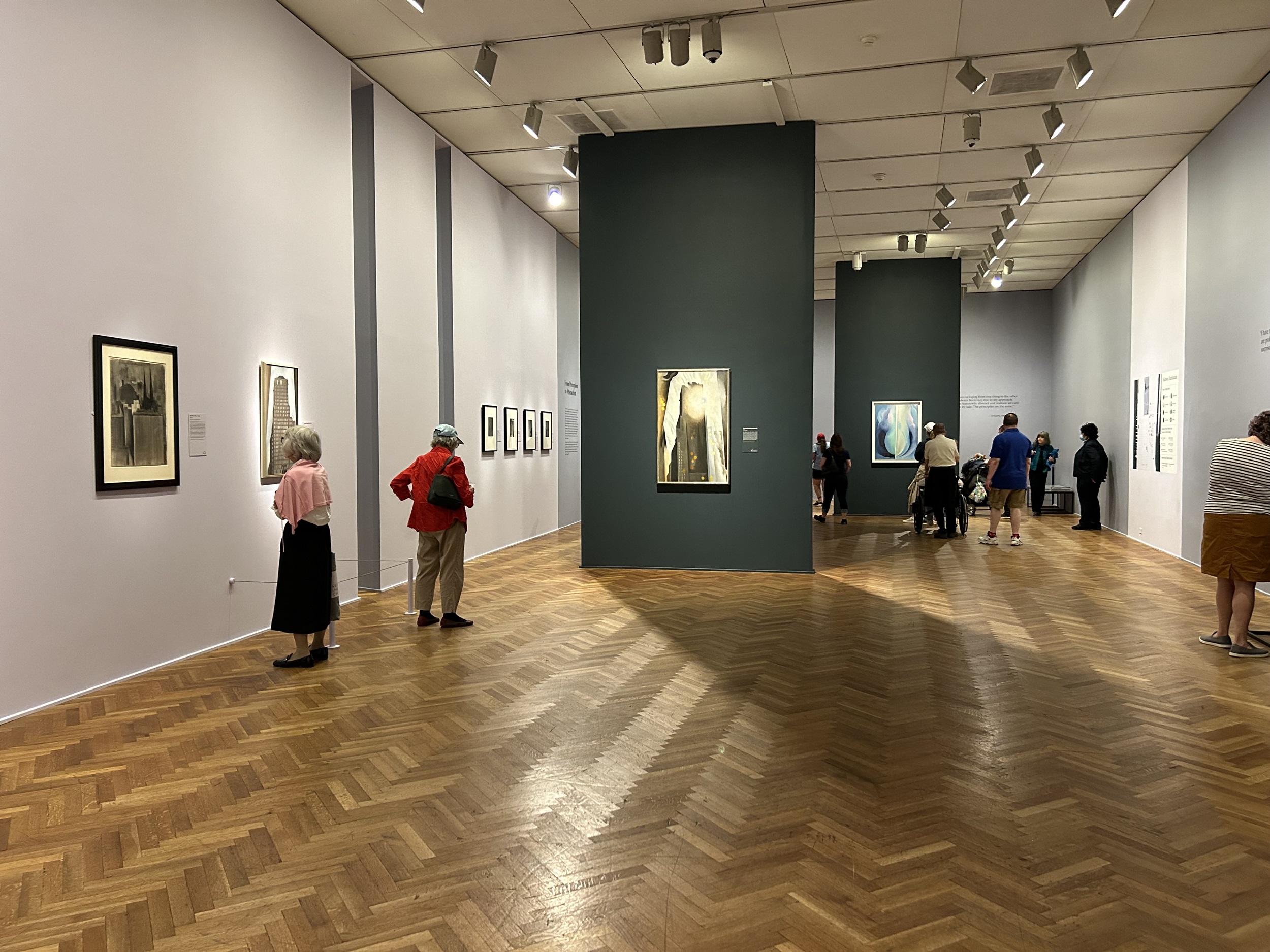
Visitors can compare her paintings of the Shelton to period photographs of the structure in a nearby case, which also includes publications and other ephemera. This array of reproductions of the Shelton’s image situates O’Keeffe’s paintings within the broader world of visual culture surrounding the hotel, giving context to her “New Yorks.” On a wall close to the Shelton paintings, a large map of sites integral to O’Keeffe’s life and work aids the viewer in grasping the geography of her Midtown world and emphasizes the sites’ proximity to one another. For a more detailed chronology of exactly when and where in the building O’Keeffe lived, as she made her home there with Stieglitz, visitors can consult Sarah Kelly Oehler’s essay in the accompanying catalogue.5
Four of O’Keeffe’s canvases in various shades of white guide the visitor through a section on perception and abstraction, around a corner, and into the next major grouping of her works. Among these, New York—Night (Madison Avenue) (1926) is one of the most effective inclusions in the exhibition to illustrate her melding of abstraction and representation. Although the work could be read as fields of white and gray with intersecting diagonal lines, her title directly refers to New York, signaling her experience of a particular place. From here, the exhibition examines O’Keeffe’s scalar experiments across subject matter, echoed in Annelise K. Madsen’s catalogue essay. Referring to her 1920s paintings of enlarged flowers, O’Keeffe said in 1962: “I’ll make them big like the huge buildings going up. People will be startled; they’ll have to look at them—and they did.”6 Pairings of works like White Flower (1929) with City Night (1926) emphasize this connection.
A short film bisects the exhibition, knitting together curatorial commentary, an overview of O’Keeffe’s biography, and historical imagery. This includes period footage of the artist on the roof of the Shelton from director and producer Perry Miller Adato’s 1977 and 2001 films, which visually place the artist in New York, since her body is implied but not shown in her own cityscapes. These scenes prepare visitors to understand the physical point of view captured in her paintings that look at and across Midtown East, the East River, and Queens from the top floors of the Shelton featured in the next major section of the exhibition.
In the following gallery, six works representing the same view show how O’Keeffe explored the urban structures and atmospheric conditions visible from the apartment she shared with Stieglitz on the top floors of the Shelton. East River from the 30th Story of the Shelton Hotel (1928), for example, portrays a clear view, crisply rendered. By contrast, East River No. 1 (1926) presents the city cloaked in a gray, intermediate haze; the viewer is not sure if the effect is caused by weather, smoke, or both. Pink Dish and Green Leaves (1928–29) is unusual in its inclusion of a portion of the interior of the artist’s apartment itself—the aforementioned pink dish rests on the windowsill, as if a surrogate for the artist’s body.
This gallery also reintroduces O’Keeffe’s relationship to photography. Following a selection of Stieglitz’s photographs of O’Keeffe in the late 1910s in the earlier section on perception and abstraction, his photographs of the same view from the Shelton line the opposite wall. The similarity between O’Keeffe’s and Stieglitz’s subject matter in this gallery might raise questions for some visitors about their influence on each other’s work—a topic that the curators leave open-ended. Art historian Lisa Volpe’s catalogue essay recounts some of the existing scholarly literature on this subject and offers further explanation of O’Keeffe’s engagement with photography—from the artist’s own use of the medium starting in the 1950s to her earlier involvement spotting Stieglitz’s photographs in his darkroom.
The final section places several of O’Keeffe’s “New Yorks” within a broader network of the artist’s movements, particularly to New Mexico, where she traveled for the first time in 1929, and the Stieglitz family compound at Lake George in northern New York State, at which she stayed periodically during this period. Recalling the curatorial strategy from the opening gallery, this section takes as its basis the artist’s 1930 exhibition at An American Place, Georgia O’Keeffe: 27 New Paintings, New Mexico, New York, Lake George, Etc. This room rejoins works that hung together in 1930, including New York, Night (1928–29), Black Cross, New Mexico (1929), and After a Walk Back from Mabel’s (1929). The didactic material stresses not only O’Keeffe’s movement between these diverse geographic places but also that of her art and things: she transferred paintings between locations, sometimes laboring on visions of the Southwest from her Manhattan home, and brought objects back East, such as the cow’s skull featured in Cow’s Skull with Calico Roses (1931). Writer, photographer, and art patron Carl Van Vechten’s photographs of O’Keeffe with the skull on the rooftop of her subsequent New York apartment reinforce this point, helping the viewer to understand how New York may have been a force in her art even when not directly pictured. The gallery concludes with O’Keeffe’s 1949 studies of the Brooklyn Bridge, described fittingly by Oehler in her catalogue essay as her “farewell” to New York (O’Keeffe moved permanently to New Mexico shortly after) and her complex cubistic canvas Manhattan (1932). The coda jumps forward in time to two small photographs she made of New York’s skyline on later trips back East and her 1970s reprise of City Night (1926).7
Just as the Shelton allowed O’Keeffe to “behold the city as a unit,” as she stated in 1928, one wishes one could take in the entirety of this exhibition at once to witness the numerous formal and historical resonances between the works.8 Illuminating some of these connections, the exhibition uses internal windows and vertical slits in the walls to create openings and fresh sightlines through her oeuvre and to stress the cohesion between O’Keeffe’s “New Yorks” and images of shells, barns, flowers, and more. For example, a wall cutout near Radiator Building—Night, New York (1927) brings into view A Celebration (1924), which depicts swirling clouds against a blue backdrop (fig. 4). The presence of wavy forms in both works draws out the organic elements in Radiator Building—Night, New York, namely the smoke or steam, as if to impress that the work is about more than just the solidity of the skyscraper city. Further, these apertures mimic the experience of moving through a city—the way in which the incidental adjacencies of the built environment frame views in striking ways.
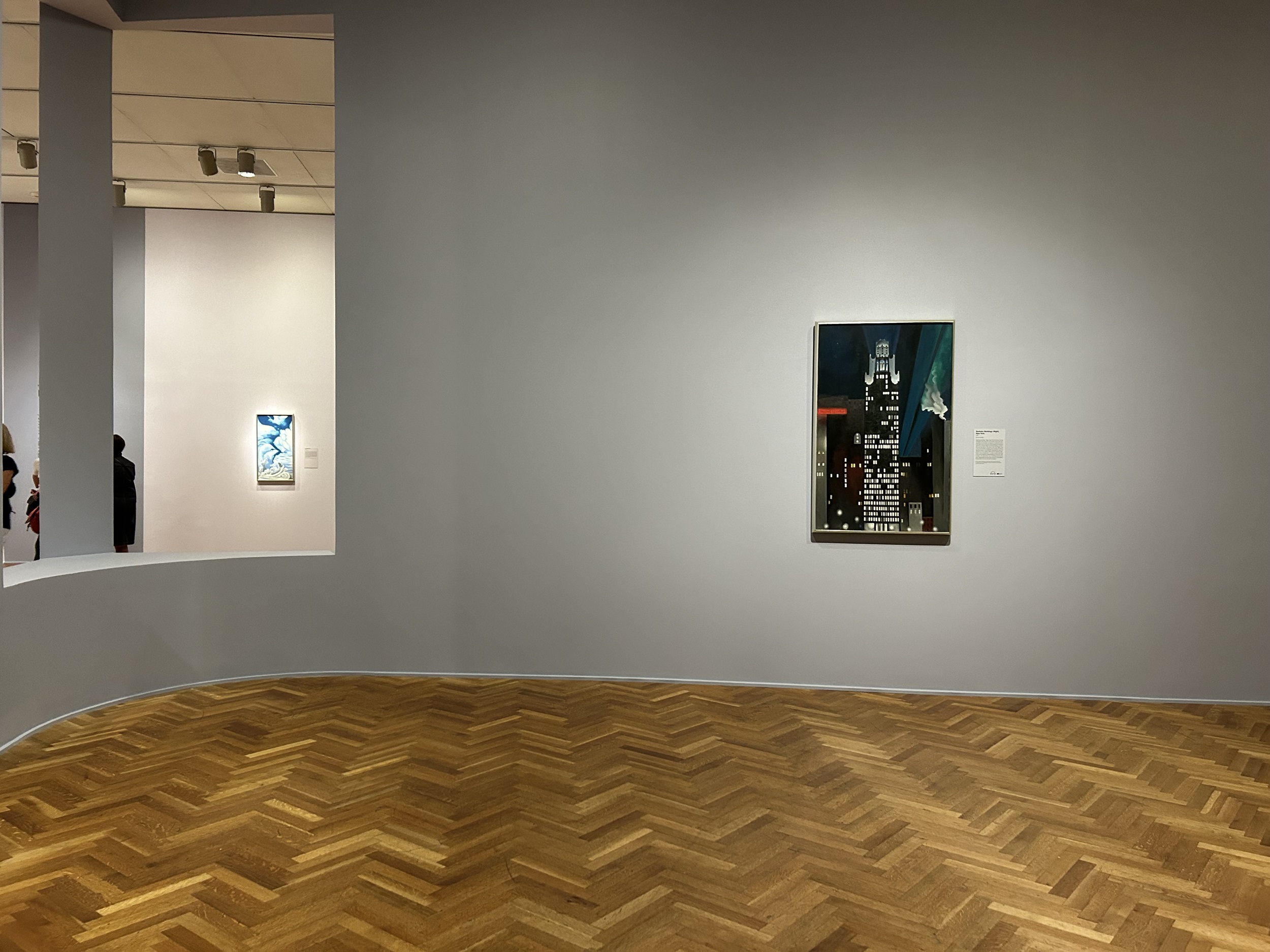
Because of the comparisons they stage, these exhibition sightlines also underscore O’Keeffe’s positionality as a white woman of European descent. Taos Pueblo (1929, reworked 1934), for instance, is framed immediately to the left of East River from the 30th Story of the Shelton Hotel (fig. 5). The horizontal format, the repeated rectangular forms, and the emphasis on architecture in these works play off each other; at the same time, this juxtaposition calls to mind ideas of colonial history and power. Art historian Sascha Scott’s essential catalogue essay adeptly argues that O’Keeffe’s “New Yorks” encode a settler gaze and perpetuate a visual culture that erased Native bodies in order to envision land as available and uncontested—in this case, the Kanien’kehà:ka (Mohawk) ironworkers who built the very skyscrapers that O’Keeffe depicts.9 While celebrating formal characteristics of the Tiwa building tradition, O’Keeffe’s painting of the Taos Pueblo omits its residents, similar to the way in which New Yorkers are absent from her depictions of the city. Additional commentary regarding the many ways in which power manifests in O’Keeffe’s works along different axes of identity, including race and gender, would be a welcome addition to the gallery walls—especially given the exhibition’s extensive use of O’Keeffe’s own words throughout, which ground the show in her voice and subject position.10
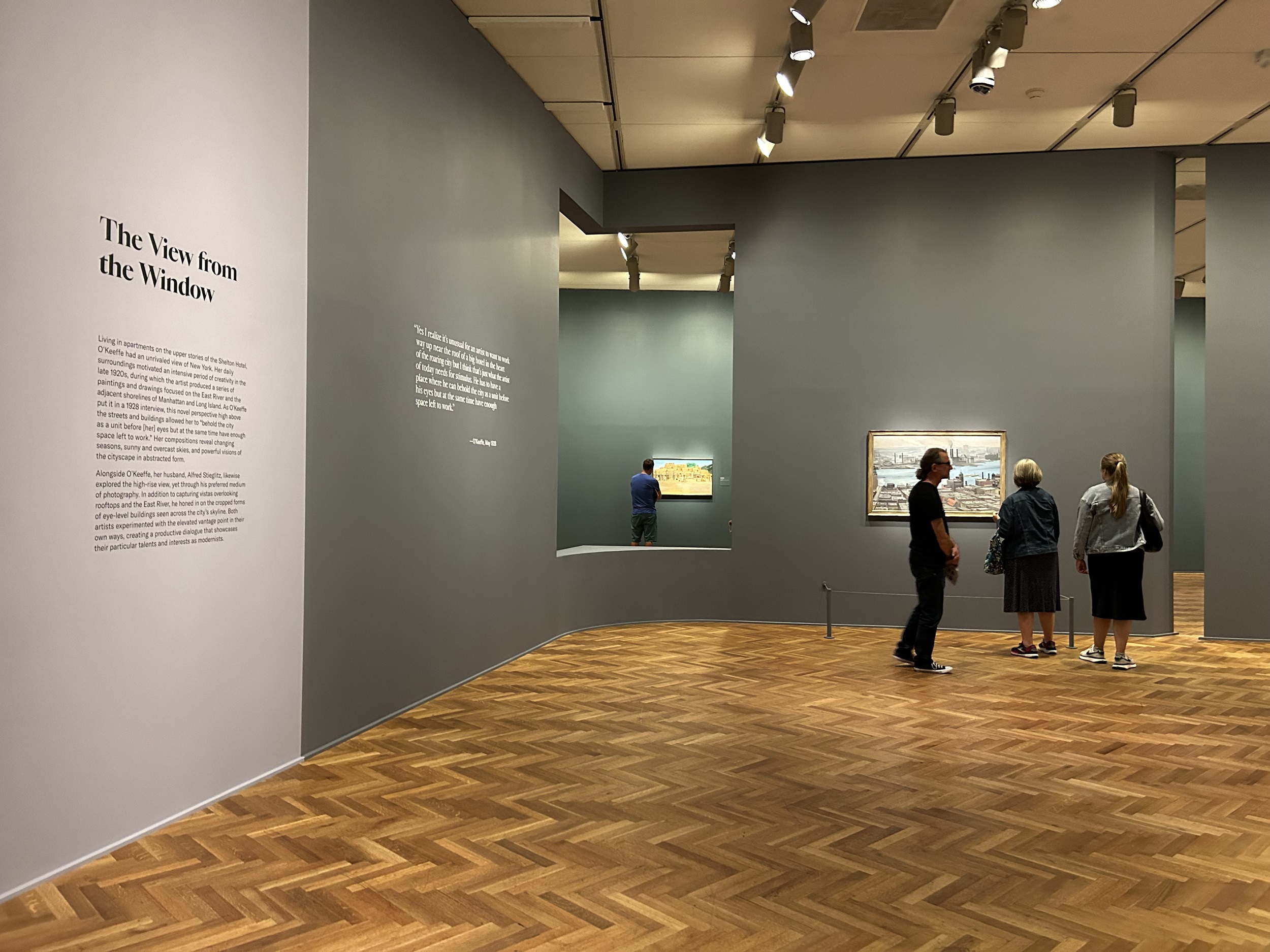
Like much existing scholarship on O’Keeffe, this exhibition focuses almost exclusively on the artist herself. While this focus is certainly warranted for the assembly of so many of her artworks that engage New York City, historian and literary scholar Adrienne Brown’s catalogue essay offers a different prompt. Brown puts O’Keeffe’s art into dialogue with another artist who was “similarly perceived as less capable of producing ‘impossible’ artistic feats” than the white male modernists: Aaron Douglas, an African American artist who was a prominent figure of the Harlem Renaissance.11 Brown situates O’Keeffe’s urban paintings alongside Douglas’s graphic metropolises of the late 1920s, productively transcending the “color line” in American modernism that has historically treated artists of different racial backgrounds separately. Although there is no conclusive evidence that O’Keeffe and Douglas met during this period, Brown offers suggestions for how their social and artistic circles may have overlapped—Van Vechten is one possible link.12 Interestingly, Van Vechten is one of the few artists other than O’Keeffe to be included in the exhibition; Stieglitz is another. With ample space in the galleries, one wonders how the inclusion of objects by makers such as Douglas might have transformed the context of O’Keeffe’s “New Yorks.” Van Vechten’s photographs could have served as a hinge to the work of artists like Jacob Lawrence or Augusta Savage, both represented in the rich collection of the Art Institute.
Through its display and catalogue, Georgia O’Keeffe: “My New Yorks” sets the stage for deeper dialogues on issues of race, gender, sexuality, coloniality, and the environment in early to mid-twentieth-century New York as they intersect with American modernism. With a primary focus on the period between 1924 and 1932, the exhibition advances existing scholarly understandings of O’Keeffe and place, underscoring that her geography included the city. Given its biographical frame and focus on urbanity, it is surprising that the show does not mention O’Keeffe’s early life in the Midwest or that she studied at the School of the Art Institute of Chicago itself. Perhaps her encounter with Chicago and its skyscrapers in the first decade of the twentieth century affected her approach to New York. O’Keeffe’s phrase “my New Yorks” implies within it an acknowledgment of the vastness of the metropolis and the myriad worlds it holds within itself. While focused on her singular perspective, the exhibition simultaneously reminds visitors that O’Keeffe’s is but one vision of the city.
Cite this article: Lee Ann Custer, review of Georgia O’Keeffe: “My New Yorks,” Art Institute of Chicago, Panorama: Journal of the Association of Historians of American Art 10, no. 2 (Fall 2024), https://doi.org/10.24926/24716839.19414.
Notes
- This phrase is taken from gallery texts and is cited several times in the exhibition catalogue. Sarah Kelly Oehler cites Georgia O’Keeffe to Henry McBride, March 1925(?), reprinted in Jack Cowart and Juan Hamilton, with Sarah Greenough, Georgia O’Keeffe: Art and Letters, exh. cat. (Washington, DC: National Gallery of Art, 1987), 179. See Sarah Kelly Oehler, “Turning the World Over: Georgia O’Keeffe Paints Manhattan,” in Georgia O’Keeffe: “My New Yorks”, exh. cat. (Chicago: Art Institute of Chicago, in association with Yale University Press, 2024), 31n2. See also Annelise K. Madsen, “Tall Buildings and Tiny Shells: Georgia O’Keeffe, New York, and the Scale of Things,” in Georgia O’Keeffe: “My New Yorks,” 51n2. ↵
- While less well known in popular culture, previous scholarship has treated these works. See, for example, Peter Kalb, High Drama: The New York Cityscapes of Georgia O’Keeffe and Margaret Bourke-White (New York: Midmarch Arts, 2003); Wanda M. Corn, “Painting Big—O’Keeffe’s Manhattan,” American Art 20, no. 2 (Summer 2006): 22–25; Vivien Green Fryd, “Georgia O’Keeffe’s ‘Radiator Building’: Gender, Sexuality, Modernism, and Urban Imagery,” Winterthur Portfolio 35, no. 4 (2000): 269–89; Anna C. Chave, “‘Who Will Paint New York?’: ‘The World’s New Art Center’ and the Skyscraper Paintings of Georgia O’Keeffe,” American Art 5, nos. 1/2 (1991): 87–107; and Lee Ann Custer, “Urban ‘Voids’: Picturing Light, Air, and Open Space in New York, 1890–1935” (PhD diss., University of Pennsylvania, 2021), 155–220. ↵
- This phrase is taken from the gallery texts and comes from Georgia O’Keeffe, Georgia O’Keeffe (New York: Viking, 1976), n.p., text accompanying entry 18. ↵
- Georgia O’Keeffe, Georgia O’Keeffe (New York: Viking, 1976), n.p., text accompanying entry 19, as cited in Oehler, “Turning the World Over,” 32n35. ↵
- Earlier scholarship has held that Stieglitz and O’Keeffe first resided in the Shelton in November 1925, but Oehler interprets their brief stay in November and December 1924 as their initial period of residence. She therefore posits that Untitled (New York) (1924–26), the charcoal drawing shown alongside The Shelton with Sunspots, N.Y. and Shelton Hotel, N.Y., No. 1, could have been completed in November 1924. See Oehler, “Turning the World Over,” 28, 33n53. ↵
- This phrase is taken from the gallery texts and comes from Katherine Kuh, The Artist’s Voice: Talks with Seventeen Artists (Harper & Row: New York, 1962), 191, cited in Madsen, “Tall Buildings and Tiny Shells,” 53n45. ↵
- Oehler, “Turning the World Over,” 30. ↵
- This phrase is taken from the gallery texts and comes from B. Vladimir Berman, “She Painted the Lily and Got $25,000 and Fame for Doing It!,” New York Evening Graphic Magazine Section, May 12, 1928, 3-M, cited in Oehler, “Turning the World Over,” 32n29. ↵
- Sascha Scott, “O’Keeffe and the ‘City of Amnesia’: US Landscape Painting and Indigenous Erasure,” in Georgia O’Keeffe: “My New Yorks,” 57. ↵
- Scott notes that while O’Keeffe was referring to her artworks with the phrase “my New Yorks,” the words resemble other instances in which she and writers commenting on her have used possessive language to describe Indigenous spaces as American, reinforcing the colonial project of Indigenous dispossession and erasure. See Scott, “O’Keeffe and the ‘City of Amnesia,’” 67–68. ↵
- Adrienne Brown, “Impossible Ideas: Seeing the City with Georgia O’Keeffe and Aaron Douglas,” in Georgia O’Keeffe: “My New Yorks,” 74–75. ↵
- Brown, “Impossible Ideas,” 75, 86n9. ↵
About the Author(s): Lee Ann Custer is a postdoctoral scholar in the Department of History of Art and Architecture at Vanderbilt University.

